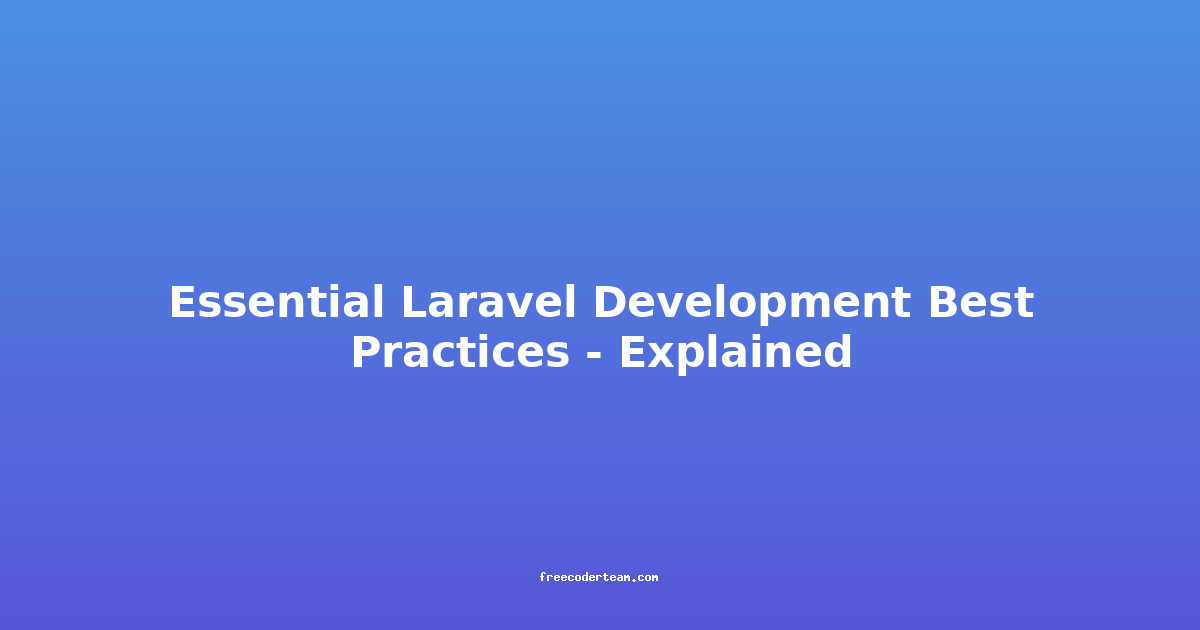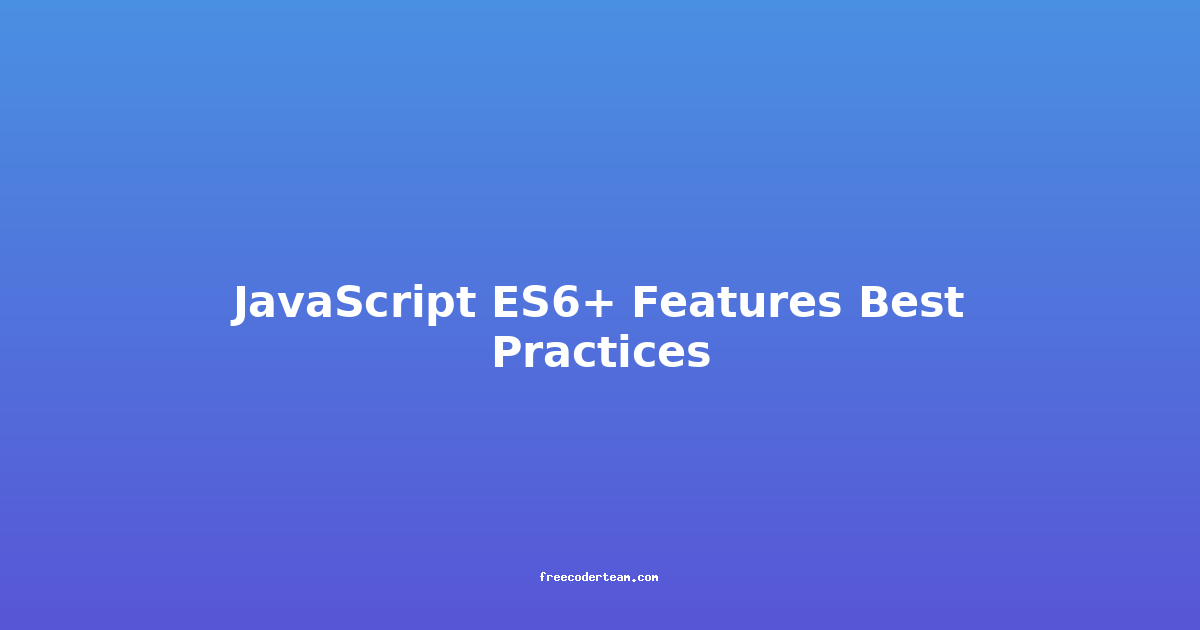Essential Laravel Development Best Practices - Explained
Laravel, a popular PHP web framework, is renowned for its elegant syntax, robust features, and developer-friendly ecosystem. However, to build scalable, maintainable, and secure applications, it's crucial to follow best practices during development. In this comprehensive guide, we'll explore essential Laravel development best practices, complete with practical examples, actionable insights, and tips to help you optimize your projects.
Table of Contents
- 1. Follow PSR Standards
- 2. Use Laravel's Artisan CLI Effectively
- 3. Implement Proper Dependency Injection
- 4. Leverage Eloquent Relationships
- 5. Handle Authentication and Authorization
- 6. Optimize Database Queries
- 7. Use Laravel's Validation and Request Features
- 8. Write Testable Code with Laravel's Testing Tools
- 9. Secure Your Application
- 10. Utilize Laravel's Caching
- 11. Maintain Clean Code with Naming Conventions
- 12. Conclusion
1. Follow PSR Standards
PHP Standard Recommendation (PSR) standards are a set of guidelines that promote consistency and readability in PHP code. Laravel follows these standards, so it's essential to adhere to them in your projects.
Why PSR?
- Consistency: Makes codebase uniform and easy to understand.
- Interoperability: Ensures your code can integrate seamlessly with other PSR-compliant libraries.
- Tooling Support: Many IDEs and tools are optimized for PSR-compliant code.
Example: PSR-12 Naming Conventions
// File: App/Http/Controllers/PostsController.php
namespace App\Http\Controllers;
use Illuminate\Http\Request;
class PostsController
{
public function index()
{
// Logic for displaying posts
}
}
Actionable Insight
- Use
composer require psr/php-fig-standardsto install PSR standards. - Use tools like PHP_CodeSniffer to check compliance.
2. Use Laravel's Artisan CLI Effectively
Laravel's Artisan CLI is a powerful tool that generates boilerplate code and automates common tasks. Leveraging it can save time and ensure your project structure remains consistent.
Example: Generating a Controller
php artisan make:controller PostsController --resource
This command creates a resource controller with CRUD methods (index, create, store, etc.).
Actionable Insight
- Use
php artisan listto explore all available commands. - Avoid manual file creation when Artisan can generate it for you.
3. Implement Proper Dependency Injection
Dependency Injection (DI) is a design pattern that promotes loose coupling and testability. Laravel's Service Container makes it easy to implement DI.
Example: Injecting a Repository
// File: App\Http\Controllers\PostsController.php
namespace App\Http\Controllers;
use App\Repositories\PostRepository;
use Illuminate\Http\Request;
class PostsController
{
protected $postRepository;
public function __construct(PostRepository $postRepository)
{
$this->postRepository = $postRepository;
}
public function index()
{
$posts = $this->postRepository->getAll();
return view('posts.index', compact('posts'));
}
}
Actionable Insight
- Use the Service Container to register dependencies in
app/Providers/AppServiceProvider.php. - Avoid using static methods for dependencies.
4. Leverage Eloquent Relationships
Eloquent provides a clean, expressive way to define and utilize database relationships. Properly modeling relationships can simplify your code and improve performance.
Example: Defining a One-to-Many Relationship
// File: App\Models\Post.php
namespace App\Models;
use Illuminate\Database\Eloquent\Model;
use Illuminate\Database\Eloquent\Relations\HasMany;
class Post extends Model
{
public function comments(): HasMany
{
return $this->hasMany(Comment::class);
}
}
// File: App\Models\Comment.php
namespace App\Models;
use Illuminate\Database\Eloquent\Model;
use Illuminate\Database\Eloquent\Relations\BelongsTo;
class Comment extends Model
{
public function post(): BelongsTo
{
return $this->belongsTo(Post::class);
}
}
Actionable Insight
- Use eager loading (
with()) to reduce N+1 query issues. - Define relationships in models for better code organization.
5. Handle Authentication and Authorization
Laravel provides a built-in authentication system and middleware for authorization. Properly managing user roles and permissions is crucial for secure applications.
Example: Implementing Middleware for Role-Based Access
// File: App\Http\Middleware\HasRole.php
namespace App\Http\Middleware;
use Closure;
use Illuminate\Support\Facades\Auth;
class HasRole
{
public function handle($request, Closure $next, $role)
{
if (! Auth::check() || Auth::user()->role !== $role) {
abort(403, 'Unauthorized action.');
}
return $next($request);
}
}
// Register middleware in Kernel.php
protected $routeMiddleware = [
'has.role' => \App\Http\Middleware\HasRole::class,
];
// Use middleware in routes
Route::get('/admin', function () {
return view('admin.dashboard');
})->middleware('has.role:admin');
Actionable Insight
- Use Laravel's
Authfacade for session-based authentication. - Implement role-based access control using middleware.
6. Optimize Database Queries
Efficient database queries are critical for performance. Laravel offers several ways to optimize queries, such as eager loading, query scopes, and pagination.
Example: Eager Loading to Avoid N+1 Queries
// Without Eager Loading
$posts = Post::all();
foreach ($posts as $post) {
echo $post->comments->count(); // N+1 query
}
// With Eager Loading
$posts = Post::with('comments')->get();
foreach ($posts as $post) {
echo $post->comments->count(); // Single query
}
Actionable Insight
- Use
->take()and->skip()for pagination. - Avoid using
->get()when you only need a single record (->first()or->find()).
7. Use Laravel's Validation and Request Features
Laravel's request and validation features help ensure that user input is clean and valid before processing.
Example: Using Form Requests
// File: App\Http\Requests\PostRequest.php
namespace App\Http\Requests;
use Illuminate\Foundation\Http\FormRequest;
class PostRequest extends FormRequest
{
public function rules()
{
return [
'title' => 'required|string|max:255',
'content' => 'required|string',
];
}
public function authorize()
{
return true;
}
}
// Use the request in the controller
public function store(PostRequest $request)
{
$validated = $request->validated();
// Save the post
}
Actionable Insight
- Use custom Form Requests for reusable validation rules.
- Validate requests before processing them.
8. Write Testable Code with Laravel's Testing Tools
Laravel's testing tools, such as PHPUnit and Laravel Dusk, enable you to write robust tests for your application. Testing ensures that your code behaves as expected and helps catch regressions.
Example: Writing a Basic Unit Test
// File: Tests\Unit\PostTest.php
namespace Tests\Unit;
use Tests\TestCase;
use App\Models\Post;
use Illuminate\Foundation\Testing\RefreshDatabase;
class PostTest extends TestCase
{
use RefreshDatabase;
public function test_can_create_a_post()
{
$post = Post::create([
'title' => 'Test Post',
'content' => 'This is a test post.',
]);
$this->assertDatabaseHas('posts', [
'title' => 'Test Post',
]);
}
}
Actionable Insight
- Use the
php artisan testcommand to run tests. - Write tests before or alongside your code (TDD/BDD).
9. Secure Your Application
Security is paramount. Laravel provides several features to help secure your application, such as CSRF protection, encryption, and rate limiting.
Example: Implementing Rate Limiting
// File: app/Http/Middleware/ThrottleRequests.php
namespace App\Http\Middleware;
use Illuminate\Http\Request;
use Illuminate\Support\Facades\RateLimiter;
use Illuminate\Http\Response;
class ThrottleRequests
{
public function handle(Request $request, Closure $next)
{
if (! RateLimiter::tooManyAttempts($request->ip(), 60)) {
RateLimiter::hit($request->ip(), 60);
return $next($request);
}
return response('Too Many Requests', 429);
}
}
// Register middleware in Kernel.php
protected $middleware = [
\App\Http\Middleware\ThrottleRequests::class,
];
Actionable Insight
- Use Laravel's built-in CSRF protection for forms.
- Encrypt sensitive data using Laravel's
Cryptfacade.
10. Utilize Laravel's Caching
Caching can significantly improve the performance of your application by storing frequently accessed data in memory.
Example: Caching Database Queries
// Cache a query result for 5 minutes
$posts = cache()->remember('posts', now()->addMinutes(5), function () {
return Post::latest()->get();
});
Actionable Insight
- Use
cache()->remember()for caching queries. - Clear the cache when data changes (
cache()->forget('key')).
11. Maintain Clean Code with Naming Conventions
Clean and consistent naming conventions make your codebase easier to understand and maintain.
Best Practices
- Classes: Use CamelCase (e.g.,
UserController,PostRepository). - Files: Use snake_case (e.g.,
user_controller.php). - Variables: Use snake_case (e.g.,
$user_id,$post_title). - Methods: Use camelCase (e.g.,
getUserById(),savePost()).
Example: Clean Naming
namespace App\Http\Controllers;
use App\Models\Post;
class DashboardController
{
public function index()
{
$recent_posts = Post::latest()->limit(10)->get();
return view('dashboard.index', compact('recent_posts'));
}
}
Actionable Insight
- Follow Laravel's naming conventions to maintain consistency.
- Use clear and descriptive names.
12. Conclusion
Laravel is a powerful framework that offers a wealth of features to simplify web development. However, leveraging these features effectively requires adherence to best practices. By following the practices outlined in this guide, you can build Laravel applications that are scalable, secure, maintainable, and performant.
Remember:
- Use PSR standards for consistency.
- Leverage Artisan for boilerplate code.
- Implement proper Dependency Injection.
- Optimize database queries.
- Write testable code.
- Secure your application with Laravel's built-in tools.
By following these best practices, you'll not only enhance your development experience but also create high-quality applications that stand the test of time.




